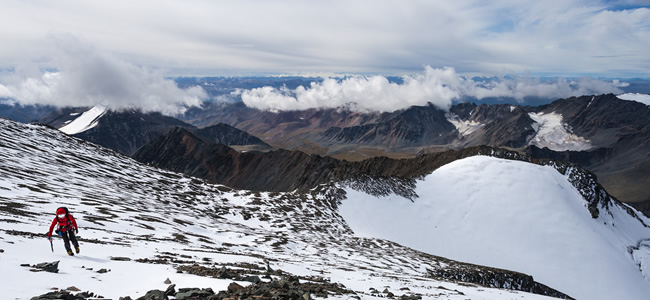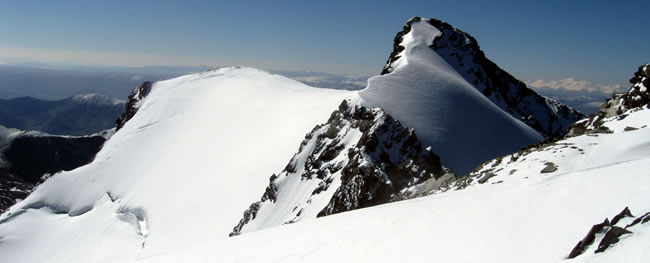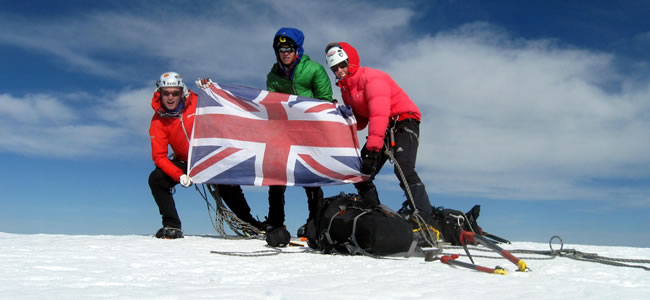Trip Summary
Download the Full Trip Report (4.6MB)
“Do you want to come climbing in Russia? There's this range called the Altai, it's near the border in the South somewhere. I think it’s a bit like the Alps”
We first heard of the Russian Altai in November 2011 at the RGS Explore conference. They sounded quite exciting - a whole region of mountains including many that even Russian climbers rarely visit, not too hard to access from the UK, and about the same height, climate and atmosphere as the European Alps.

Fast forward nine months, and we have returned. Myself (George Cave), Eleri Dawson, Clay Conlon and Greg Annandale spent just under 3 weeks in Russia, on our first self-supported remote expedition, exploring the peaks surrounding one of the valleys of the South Chuyski Range. Flights from London Heathrow to Barnaul in the Altai Republic took around 12 hours (including a stopover in Moscow), and with Clay and Greg acting as the advance party to purchase food and fuel we hit the ground running at 6am on the morning of Sunday 12th August.
Our fixer, Igor at K2 Adventures, had arranged transport from Barnaul airport to Kurai (12 hours in a big yellow van), followed by a 4x4 the next day for the trip up to basecamp. Due to recent local flooding, the rivers were far more swollen than expected and we were forced to stop 10km shy of our proposed camp. With around 50kg of food, fuel and equipment each to carry in we lost a day from our schedule simply trying to get to our preferred basecamp site. However, once there we found ourselves in a magnificent amphitheatre of rocky slopes and ridges complete with a chilly lake for bathing. When storms arrived, the water on the surface was whipped around in a turbulent frenzy of ever-changing directions and we came to think of the area as lying at the centre of the world.

We had 9 days available to explore as much of our end of the South Chuyski Range as we could. Climbing in pairs, we undertook a series of Alpine style attempts on the different peaks, starting either from basecamp or a bivy site depending upon the route. We were fortunate to have brought a large pile of 1:50k maps, printed out the night before departure using files sent through from the Alpine Club. They proved very useful, despite huge discrepancies between the edges of glaciers on the map and on the ground (not just in recession!). Irbistu, meaning Snow Leopard Peak, stands 3967m tall and was summited both from the SW slopes and the much more challenging N ridge. The glacially capped dome of Dzhaniktu (3942m) was climbed in a 12 hour traverse N > S. Two further 3700m peaks provided additional routes, giving us a total of 5 Alpine routes and 8 summits.
On the whole, the snow and ice was of reasonable quality, however the same could not be said for the rock. We were promised by a local climber before arrival to expect "a rain of rocks all around you" and we were not disappointed. Many approach ridges were no more steep and sheer than the hardest UK scrambles, but the lack of integrity in the bedrock presented a constant danger of the collapse of both hand and foot holds. Leader placed protection was effectively impossible to arrange and all major difficulties on rock were soloed. We also beat a hasty retreat from an approach glacier at 4am due to the ominous groaning and cracking spreading out under our feet. Despite these adventures, we returned having suffered no major injuries or illnesses.

To conclude, the area holds great potential for future exploration, but we would recommend a visit a little earlier in the season. A distinct lack of snow cover might have made life easier for the herds of Yak who roamed the valley but we could have benefited from less arduous moraine on some of the approaches and descents. Those Russians who have visited the region appear to favour visits in late spring or early summer.
Finally, we must acknowledge the support of the MEF, BMC & Alpine Club for providing funds which made the expenses of such a trip much more bearable. Furthermore, we were most grateful for the gift and/or loan of kit from Berghaus, Alpkit & Buffwear.
Time to start planning the next trip now.
George Cave
September 2012
